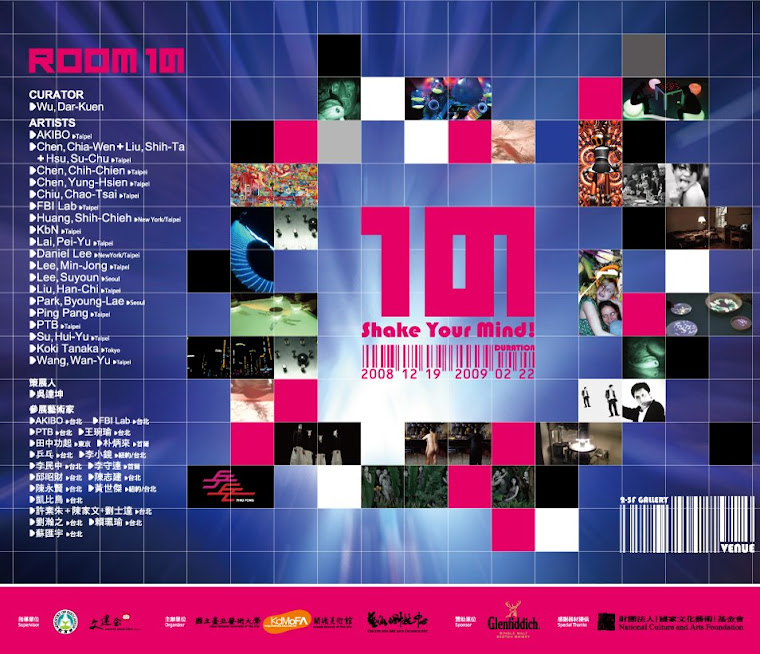.jpg)
--- 夜都市生存攻略------------------
--- 越夜越美麗,夜戀時代來臨----
---- 屬於自己的ROOM19 -----------
2009.1月8日(四). 14:00~16:30 .台北藝術大學 關渡美術館 3F多功能會議室
報名方式 : 來電02-28961000轉2432
ROOM19座談會,由ROOM19策展人吳達坤主持,分享本展的策展概念與過程。
並邀請到兩位國際知名策展人跟藝評家 胡朝聖、鄭慧華一同參加,
以文化觀察及事件開創者的多重觀點出發,從個人參與的自身經驗出發談論夜間文化的豐富可能。
與會專家將對ROOM19的展覽,展開學術性的對談,跨領域的直接對話,精彩可期,並分享文化如何串連開放的新可能性!
請歡迎各界關心本展的藝文愛好朋友們共襄盛舉。
------
主持人簡介:
[吳達坤]
藝術家暨獨立策展人
目前在台北生活及工作,台北藝術大學美術創作碩士,VT ARTSALON視覺總監。專事藝術創作及展覽策劃,主要媒材以空間裝置、新媒體及公共藝術為主,國內外展出經驗豐富,亦常發表評論文章於各類藝術雜誌。2002年北歐NIFCA國際藝術村駐村,2004年獲國巨科技藝術獎赴紐約Location One藝術村駐村,2006獲文建會紐約ISCP駐村,2008年赴東京Tokyo Wonder Site 駐村。近期展演:『感官拓樸-台灣當代藝術體感測』、『科光幻影2008 對話之外』、『Dumbo art under the bridge Festiva』、『波音計劃-Waveset Stretching』、『雅加達CP雙年展』、『2007 Art in TaeGu大邱國際藝術節』、『出神入畫―華人當代攝影展》、『第十屆大阪當代藝術三年展』等等。近期互動錄影作品『迷樓系列』,於國立台灣美術館、韓國光州美術館展出,並獲國立台灣美術館典藏。
其他跨領域影像演出作品:泰順街唱團『盜火計劃/前衛科技慢舞/中板』、與「NCO」合作劇場影像。參與策劃展覽有:「夜視‧台北」國際錄影藝術展、『腦天氣』錄影藝術節、『從這裡到那裡-藝術的移動經驗』文建會第七屆駐村藝術家聯展、Blue Dot Aisa「幻影劇場」—台灣當代新藝術、2008年底於關渡美術館策劃「ROOM19」…等展覽。
參與來賓簡介:
[胡朝聖 Sean C.S. Hu] http://blog.roodo.com/chao_sheng1008
獨立策展人
出生於台灣。現為策展人、國立台灣藝術大學與台北教育大學講師、作家、中華民國視覺藝術協會理事、忠泰建築文化藝術基金會董事以及胡氏藝術公司執行長。曾於2008年策畫上海國際當代藝術博覽會年度特展『Best of Discoveries』台灣區策展人、台北國際畫廊博覽會主題展『遊』、『既視之方』、2007年『流行的意外』、『粉樂町』東區當代藝術展、『晴耕雨讀』林銓居行為地景藝術展、『深呼吸』新媒體藝術展、2006年『共振』聯展、2005年『快感 奧地利電子藝術節25年大展』、2003年『南港軟體工業園區公共藝術案—實擬虛境』、『夜視‧台北』國際錄影藝術展、2001年『粉樂町—台灣當代藝術』國際巡迴展等。2005年出版『魔幻城市---科技公共藝術』專書。
[鄭慧華]
獨立策展人 ,藝術評論者及獨立策展人,工作和生活於台灣台北和加拿大溫哥華兩地。
自1995年開始撰寫藝術相關文章,95年至2000年任時報周刊特約作者、97年至99年任輔仁大學夜間部英文系兼任講師,並為《藝術新聞》雜誌特約撰搞;2000年開始任《典藏今藝術》溫哥華特約作者,現為該雜誌特約主筆。近年藝術評介與評論文章散見於:《今藝術》、《現代美術》(台北市立美術館出版)、《YiShu:Journal of Contemporary Chinese Art》等期刊。
2002年譯作〈左岸琴聲〉(商周出版)、2003年譯作〈嬉戲〉(商周出版)、2004年譯作〈正午的惡魔〉(源水文化出版)。鄭慧華策劃過的展覽包括: 看不見的城市(溫哥華亞洲當代藝術國際中心 2003),穿越-廢墟與文明 (台北誠品藝文空間2004)、與比利時策展人范黛琳(Barbara Vanderlinden)共同策劃2004台北國際雙年展:在乎現實嗎? (台北市立美術館 2004),以及疆界(台北市立美術館 2006)。
主辦單位:國立台北藝術大學關渡美術館、科技與藝術中心
時間:2009年1月8日(星期四),下午2:00~4:30
地點:國立台北藝術大學關渡美術館3F多功能會議室























